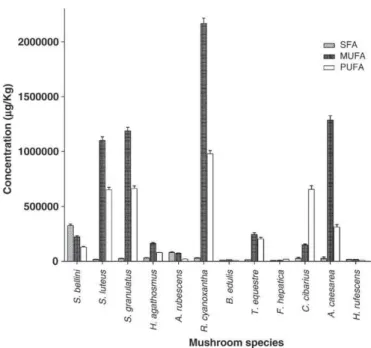Author's personal copy Fatty acid composition of wild edible mushrooms species: A comparative study
Texto
Imagem

Documentos relacionados
Regarding the monounsaturated fatty acids (MUFA), oleic acid was the predomi- nant one in pomegranate seed oils and accounted 3.1 to 5.7% of total fatty acids for the White
Decreased levels of palmitic acid, myristic acid and carnitine, the carrier of fatty acids, were observed in colorectal cancer sera compared to healthy controls (13). Fatty
The retention capacity of encapsulated glucose solutions in lipid microparticles with lipid mixtures of solid-liquid fatty acids (stearic acid – oleic acid) in relation
Huitlacoche was analyzed in terms of proximate composition, fatty acids, mineral elements, total phenolic and flavonoid matters and antioxidant activity.. Of the 11 fatty acids,
The fatty acid profile showed that linoleic acid, palmitic acid, oleic acid, stearic acid and linolenic acid (above 0.55 g/100 g) as the most abundant fatty acids followed
Esta conceção, inicialmente elaborada por Umberto Eco na obra Apocalípticos e Integrados, suscitou desde logo um profundo debate: os últimos viam a cultura de massas como
Changes in the trends of fatty acids profile (palmitic, oleic, linoleic and linolenic acids), some of mineral elements (Fe, Mg, Ca and P) and chlorophyll contents were similar